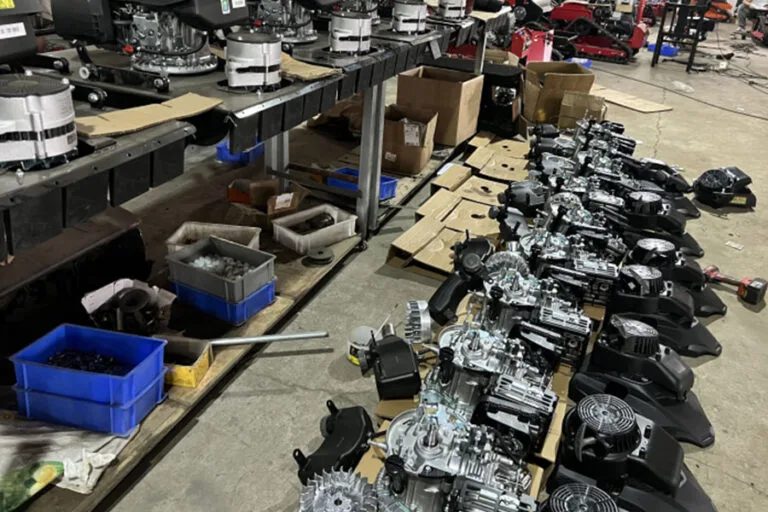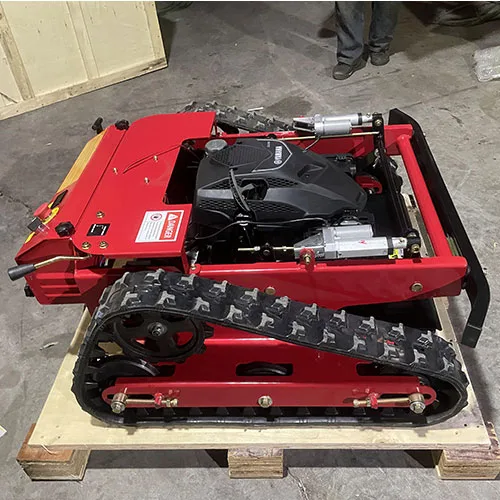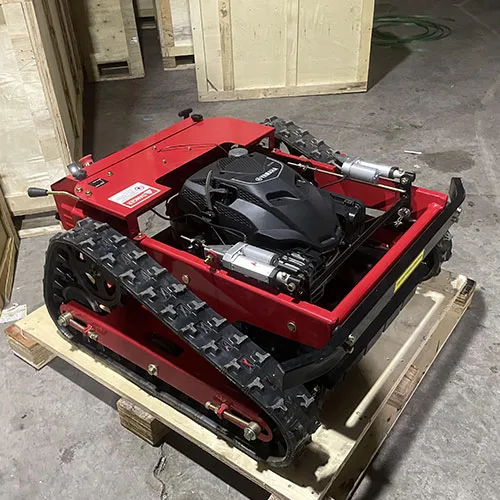I’m thrilled to have you here! Before we dive into the content, let’s stay connected. Join me on my social media platforms for more insights, community engagement, and regular updates. Here’s where you can find me:
📌 Facebook: Shandong Huaying International Trade Co., Ltd.
Now, let’s embark on this journey together. I hope you find the content here not only insightful and engaging but also valuable to your interests. Let’s learn, grow, and connect!
Table of Contents
Introduction

Selecting the right remote control lawn mower commercial unit is a decision that can significantly impact operational efficiency, safety, and long-term value. In commercial landscaping, municipal maintenance, and industrial site management, these machines play a vital role. However, making uninformed choices can result in costly setbacks, operational inefficiencies, and even safety hazards.
This article will explore six common but expensive mistakes businesses make when choosing a remote control lawn mower commercial unit. By identifying these pitfalls and offering clear, actionable advice, this guide aims to help purchasers make smarter decisions and maximize their return on investment.
Mistake 1: Ignoring Terrain Compatibility
One of the most frequent yet overlooked issues when selecting a remote control lawn mower commercial unit is failing to match the equipment with the terrain. These machines are not one-size-fits-all—some are ideal for flat, manicured lawns, while others are engineered for steep slopes, rocky inclines, and uneven ground.
If you use a mower on terrain it wasn’t designed for, you’re inviting performance issues and safety hazards.
Problems this mistake can cause:
- Reduced cutting efficiency on hilly or uneven surfaces
- Higher chance of machine damage due to improper balance or tip-overs
- Poor traction, slipping, or jerky operation that compromises control
Best Practice:
Before making a purchase, thoroughly evaluate the landscape where the mower will be used most often. Is the area primarily grassy flatland, or are there banks, ditches, and inclines? Choose a model with a low center of gravity, reinforced treads or tracks for grip, and features like dynamic slope stabilization. Models with adjustable blade height and built-in tilt sensors are also beneficial for maintaining optimal performance across different terrains.
Mistake 2: Overlooking Safety Features
Safety is paramount, especially in commercial settings. Some buyers prioritize cost over safety, which can lead to In commercial landscaping or municipal groundskeeping, safety isn’t optional—it’s a requirement. Yet many procurement decisions still focus too heavily on price, ignoring critical safety technologies embedded in modern robotic mowers. A lack of robust safety features can put both operators and bystanders at risk, leading to accidents and potential liability.
Common oversights include:
- Absence of emergency stop or kill switch
- No real-time obstacle detection or collision avoidance
- Inadequate signal range, leading to loss of control over the unit
Recommendation:
Always verify that the unit complies with industrial safety regulations or certifications (such as CE, ISO, or ANSI standards). Key safety upgrades to look for include automatic shutoff when obstacles are detected, tilt and lift sensors, and a return-to-home function. If the mower is to be used in public or high-traffic areas, advanced safety protocols are especially important. Investing in these features up front will mitigate risk and protect both personnel and property.
Mistake 3: Neglecting Battery Life and Power Output


A remote-controlled mower may seem impressive on paper, but if its battery doesn’t last through a standard work session or lacks the power to tackle dense overgrowth, it can become more of a burden than a help. Downtime due to frequent recharges or bogged-down motors results in inefficiency—and in commercial operations, that means lost revenue.
Negative consequences of insufficient power:
- Frequent battery depletion disrupts work schedules
- Motor stall-outs when cutting thick or wet grass
- Longer job times and reduced overall productivity
Advice:
Before purchasing, scrutinize technical specifications such as amp-hour (Ah) ratings, maximum runtime per charge, and motor torque output. For high-demand jobs, units with fast-charging batteries, hot-swap functionality, or hybrid systems (battery plus gas assist) can drastically improve operational uptime. Also, consider external battery packs or mobile charging stations if you’re working on remote or large properties.
Mistake 4: Choosing the Wrong Cutting Width
Larger is not always better—especially when it comes to deck width. While a wider cutting path can speed up mowing on large open areas, it can be a major disadvantage in tight, complex spaces where agility is more valuable than breadth. This mistake often arises when buyers don’t assess the practical limitations of their working environments.
Key factors to consider:
- Presence of trees, benches, fences, or playground equipment
- Narrow passages or curved landscaping edges
- Transport constraints if you frequently move equipment between sites
Pro Tip:
Measure the average width of your mowing zones and plan for the narrowest areas. It’s often beneficial to choose a model with a modular deck that can be expanded or contracted depending on job requirements. Some robotic mowers even offer variable blade configurations to switch between precision and speed modes. In urban or ornamental settings, precision and maneuverability outweigh raw deck size.
Mistake 5: Failing to Verify Remote Control Range and Reliability
A crucial but often overlooked factor in selecting a remote control lawn mower commercial unit is ensuring the reliability and effective range of its remote control system. Since these machines depend entirely on wireless communication between the operator and the mower, any disruption in signal quality can severely impact performance and safety.
Common consequences of poor remote control range or unstable connectivity include:
- Interrupted or dropped signal transmission, causing the mower to stop unexpectedly
- Inaccurate navigation, leading to missed spots or collisions with obstacles
- Increased operator frustration due to inconsistent control and delayed tasks
- Potential safety hazards if the mower moves unpredictably or loses communication in hazardous zones
Recommended solution:
Always choose a remote control lawn mower commercial model with a proven, tested wireless system that guarantees stable control over long distances. The operational environment also matters: signal interference from buildings, trees, or weather conditions can degrade performance. Before finalizing your purchase, read detailed user reviews, manufacturer signal range specifications, and test results under various real-world conditions. Selecting equipment with robust communication protocols and fallback safety features can significantly reduce operational risks and enhance overall mowing efficiency.s.
Mistake 6: Underestimating After-Sales Support and Parts Availability
The remote control lawn mower commercial market is expanding, but not all manufacturers offer reliable customer The expanding market for remote control lawn mower commercial equipment offers many attractive options, but not all manufacturers maintain the same level of after-sales service and spare parts availability. Neglecting to verify these aspects can result in costly downtime and frustration, especially for businesses relying on continuous operation.
Risks associated with poor after-sales support and parts scarcity include:
- Extended machine downtime while waiting for replacement components or repairs
- Higher overall maintenance expenses due to lack of timely service or non-genuine parts
- Inadequate technical assistance, leading to prolonged troubleshooting and operational delays
Guidelines for smart purchasing:
Prioritize remote control lawn mower commercial brands and suppliers known for their responsive customer support teams and transparent maintenance documentation. Investigate the availability and delivery time of common replacement parts such as batteries, blades, motors, and control units before making your purchase decision. Additionally, consider whether the manufacturer offers training resources or dedicated service centers that can assist with technical issues swiftly. Investing time in evaluating after-sales reliability upfront ensures your commercial mowing operations run smoothly with minimal interruptions.
Remote Control Lawn Mower Commercial Feature Comparison Table
| Feature | Entry-Level Model | Mid-Range Model | High-End Commercial Unit |
|---|---|---|---|
| Terrain Compatibility | Flat terrain only | Moderate inclines | All-terrain, steep slopes |
| Safety Mechanisms | Basic | Emergency stop | Sensors, shutoff, full protocol |
| Battery Life | 60–90 minutes | 2–3 hours | 4+ hours with swappable battery |
| Cutting Width | Fixed (18–24 in) | Moderate (24–36 in) | Adjustable (36+ in) |
| Remote Range | 100 meters | 200–300 meters | 500+ meters with anti-lag tech |
| After-Sales Support | Limited | Standard | Premium with parts hotline |
Conclusion
Investing in a remote control lawn mower commercial model should be based on thorough research and alignment with your operational goals. Mistakes like ignoring terrain compatibility or settling for poor after-sales service can dramatically reduce efficiency and ROI. By understanding these six costly pitfalls and using our comparison table as a checklist, buyers can make more informed decisions and secure the full benefits of modern mowing technology.
When chosen wisely, a high-quality commercial remote mower offers unmatched productivity, safety, and environmental control—transforming maintenance tasks into streamlined operations.
FAQ
What’s the ideal slope capacity for a commercial unit?
When selecting a remote control lawn mower commercial model, slope capacity is a critical factor to consider, especially if your property features hills, embankments, or uneven terrain. Ideally, you want machines capable of handling slopes up to 45–50 degrees. This ensures the mower can safely and effectively operate on steep inclines without risk of tipping or losing traction. Models with advanced traction control and low centers of gravity tend to perform best on such challenging landscapes. Always verify the slope specifications in the product details to ensure your chosen remote control lawn mower commercial unit matches your terrain’s demands.
Are remote control lawn mower commercial units safe for public use?
Safety is a top priority for any remote control lawn mower commercial equipment intended for use in public spaces such as parks, schools, or municipal grounds. Modern units come equipped with a variety of advanced safety features including proximity sensors, automatic stop mechanisms, and emergency shutoff controls. Many models comply with rigorous commercial safety certifications to guarantee operator and bystander protection. These technologies help prevent collisions, reduce noise pollution, and enable the mower to pause instantly if an obstacle or person is detected nearby. Therefore, well-designed remote control lawn mower commercial machines are safe and reliable options for public use.
How often should these machines be serviced?
Regular maintenance is essential to keep any remote control lawn mower commercial unit performing at its peak. As a general rule of thumb, servicing every 100 to 150 hours of operation is recommended. However, the exact frequency depends on the mower’s usage intensity, operating conditions, and manufacturer guidelines. Routine checks typically include blade sharpening or replacement, battery health assessments, lubrication of moving parts, and inspection of control systems. Adhering to scheduled maintenance not only prolongs the lifespan of the mower but also helps prevent costly breakdowns, ensuring your remote control lawn mower commercial investment continues to deliver consistent results.
Can one operator control multiple units?
Efficiency improvements in remote control technology have made it possible for a single operator to manage multiple remote control lawn mower commercial units simultaneously, especially in large-scale commercial or municipal operations. Some high-end models feature integrated control platforms or software that allow centralized command of several mowers, optimizing workflow and reducing labor costs. However, successful multi-unit control requires comprehensive training to ensure operators can monitor and respond to each machine’s status effectively. Always evaluate the control system capabilities and consider your team’s expertise before implementing multi-unit remote control lawn mower commercial solutions.
What maintenance parts wear out the fastest?
In the lifecycle of a remote control lawn mower commercial machine, certain components experience more wear and tear due to regular operation. The most commonly replaced parts include cutting blades, drive belts, and batteries. Blades often require frequent sharpening or swapping because they face direct contact with tough grass, weeds, and debris. Drive belts can degrade over time, affecting power transmission and mobility. Batteries, especially in electric or hybrid models, have finite charge cycles and eventually need replacement to maintain optimal runtime. When selecting a remote control lawn mower commercial unit, look for models designed with easily accessible parts to facilitate quick maintenance and minimize downtime during servicing.




